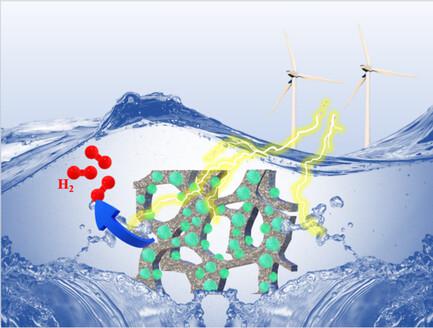Harnessing Wind Energy for Ultraefficient Green Hydrogen Production with Tin Selenide/Tin Telluride Heterostructures
IF 8.3
Q1 MATERIALS SCIENCE, MULTIDISCIPLINARY
引用次数: 0
Abstract
Industrialization of green hydrogen production through electrolyzers is hindered by cost-effective electrocatalysts and sluggish oxygen evolution reaction (OER). Herein, a facile one-step hydrothermal technique for the in situ growth of non-noble tin chalcogenides and their heterostructures on nickel foam (NF) as trifunctional electrocatalysts for hydrogen evolution reaction (HER), OER, and methanol oxidation reaction (MOR) is detailed. Among them, the heterostructured SnSe/SnTe/NF outperforms all others and recently reported catalysts, boasting an impressively low potential of −0.077, 1.51, and 1.33 V versus reversible hydrogen electrode to achieve 10 mA cm−2 for HER, OER, and MOR. Owing to the rod-like morphology with hetero-phases for enhancing the performance. Furthermore, a hybrid MOR-mediated water electrolyzer requiring only 1.49 V to achieve 10 mA cm−2 with value-added formate is introduced and traditional water electrolyzer is outperformed. Additionally, a zero-gap commercial anion-exchange membrane water electrolyzer (AEMWE) with bifunctional SnSe/SnTe/NF electrodes is tested, successfully achieving an industrially required 1 A cm−2 at a low potential of 1.93 V at 70 °C. Moreover, AEMWE using a windmill is powered and H2 and O2 production with wind speed is measured. Overall, this work paves the development of unexplored tin chalcogenide heterostructure as a potent candidate for cost-effective, energy-efficient, and carbon-neutral hydrogen production.

利用风能与硒化锡/碲化锡异质结构实现超高效绿色制氢
通过电解槽进行绿色制氢的工业化生产受到成本效益高的电催化剂和缓慢的氧进化反应(OER)的阻碍。本文详细介绍了一种在泡沫镍(NF)上原位生长非纯锡胆原化物及其异质结构的简便一步水热法技术,该技术可作为氢进化反应(HER)、氧进化反应(OER)和甲醇氧化反应(MOR)的三重功能电催化剂。其中,异质结构的 SnSe/SnTe/NF 优于所有其他催化剂和最近报道的催化剂,与可逆氢电极相比,其电位分别为 -0.077、1.51 和 1.33 V,可实现 10 mA cm-2 的 HER、OER 和 MOR。这归功于具有异相的棒状形貌,从而提高了性能。此外,还引入了一种混合 MOR 介导的水电解槽,只需 1.49 V 即可实现 10 mA cm-2 的甲酸盐增值,其性能优于传统的水电解槽。此外,还测试了采用双功能 SnSe/SnTe/NF 电极的零间隙商用阴离子交换膜水电解槽(AEMWE),该电解槽在 70 °C 条件下以 1.93 V 的低电位成功实现了工业所需的 1 A cm-2。此外,还利用风车为 AEMWE 供电,并测量了随风速产生的 H2 和 O2。总之,这项工作为开发尚未开发的锡钙钛矿异质结构铺平了道路,使其成为具有成本效益、高能效和碳中性制氢的有效候选材料。
本文章由计算机程序翻译,如有差异,请以英文原文为准。
求助全文
约1分钟内获得全文
求助全文
来源期刊
CiteScore
14.00
自引率
2.40%
发文量
0
期刊介绍:
Small Science is a premium multidisciplinary open access journal dedicated to publishing impactful research from all areas of nanoscience and nanotechnology. It features interdisciplinary original research and focused review articles on relevant topics. The journal covers design, characterization, mechanism, technology, and application of micro-/nanoscale structures and systems in various fields including physics, chemistry, materials science, engineering, environmental science, life science, biology, and medicine. It welcomes innovative interdisciplinary research and its readership includes professionals from academia and industry in fields such as chemistry, physics, materials science, biology, engineering, and environmental and analytical science. Small Science is indexed and abstracted in CAS, DOAJ, Clarivate Analytics, ProQuest Central, Publicly Available Content Database, Science Database, SCOPUS, and Web of Science.

 求助内容:
求助内容: 应助结果提醒方式:
应助结果提醒方式:


